Attachment and Systemic Family Therapy
DOI:
https://doi.org/10.33898/rdp.v29i111.260Keywords:
pyshcological explanation, developmental history, traima, attachment diagnosis, attachment reorganizationAbstract
The authors show how the theory of attachment has been fundamental to help part of the movement of family therapy to get rid of the limits of a systemic purism that doesn’t consider the evolutive history of the patient and that focuses only on the resources ignoring the limits of the patients and of their families. The theory of attachment is decisive to build up hypotheses, which do not remain confined in the here and now: it can be used as a deductive map that helps the therapist in his work of making hypotheses not only on the development of the patient, but also on problems regarding his childhood and on the reactions of the caregiver. The five re-organizations of the disorganized attachment are a useful guide that puts together the individual personality traits with their possible relational schemes. They help to understand the evolutive paths that lead to different personality disturbs. In this way not only the strategic subject is focused but also the suffering one. These theoric thoughts are explained in a more extensively exposed clinic case and other more concise examples.
Downloads
Downloads
Published
How to Cite
Issue
Section
License
Authors who publish in this journal accept the following conditions:
-
Authors retain copyright and grant the journal the right of first publication, with the work registered under the Creative Commons CC-BY-NC 4.0 International license. This license allows third parties to cite the text and use it without alteration and for non-commercial purposes, provided they credit the authorship of the work and its first publication in this journal.
-
Authors may enter into other independent and additional contractual agreements for the non-exclusive distribution of the version of the article published in this journal (e.g., including it in an institutional repository or publishing it in a book), provided they clearly indicate that the work was first published in this journal.
-
The views expressed in the articles are solely the responsibility of the authors and in no case do they reflect the opinions or scientific policies of the journal.









